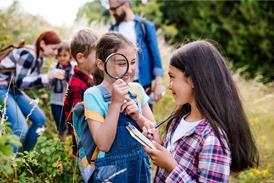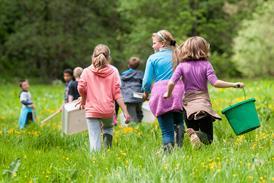.jpg)
Education officers Hywyn Williams and Angharad Harris from Snowdonia explain why the Welsh National Park’s mountainous environment is a great one for learning outside of the classroom.
Education on a mountain
There’s been an education service associated with Snowdonia since its designation as a National Park in 1951, although, as Williams and Harris point out, it could be argued that the unique landscape of the region has been used as an outdoor classroom for centuries.
“We think the landscape of Snowdonia is as an ideal educational destination, and there is a team of specialist staff members who can bring this landscape to life for pupils with their expert knowledge.
Snowdonia has mountains and coasts to study and accessible locations for field work, be it glaciation or moorlands.”
History and Science as well as Geography
When it comes to looking at the mountainous environment of Snowdonia, Geography seems to be the obvious school subject link – but don’t be fooled into thinking that other subjects don’t get a look in.
“The contrasting landscapes of Snowdonia provide an outdoor platform for several learning opportunities in the outdoors. Aspects of our services tie into the National Curriculum for Science and History, with Literacy and Numeracy thrown in for good measure.”
For example, Secondary school History students can be introduced to the principles behind the 1949 National Park and Access Act. The class will learn about how the Snowdonia National Park functions in relation to the act, and why it is important to understanding that the act is the reason behind the existence of the National Park network in Britain.
Teachers opting for such a topic focus during a trip will see their students learn about conserving natural beauty, wildlife and cultural heritage, and discovering information about the social wellbeing of local communities within the National Park.
Outside of the National Curriculum there are plenty of learning options for school teachers to choose from as well.
“Teachers may want a mountain experience and a walk to Llyn Llydaw on Snowdon, where we’ll tell the story of the mountain to tie in with the history of the landscape,” Williams and Harris tell us.
“Alternatively you may want to look at the impact of tourism within Snowdonia by visiting one of our honey pot sites and looking at the land use. Or, if you’re after legends [to tie in with English], we’ll take you on a Legendary Walk to listen to the tale.”
.jpg)
Pictured: Pupils studying a map at Cwm Idwal, Northern Snowdonia.
Natural resources to aid learning
When it comes to learning resources, the landscape of the area seems to provide more than enough regardless of material objects.
The education officers stressed: “We’re enthusiastic about leading classes on a learning experience that focuses on seeing and listening. The staff provide a wide range of teaching resources, from an informal walk and talk on Snowdon, to in-depth location studies of landscape and conservation, as well as human influences on protective designations [of land].”
If you are after some hard evidence of educational resources however, the Snowdonia National Park website offers various ideas for ways to enhance a visit.
These range from a planning jigsaw allowing students to explore what the future for Snowdonia might be like, to pages about learning why accidents happen in the mountains. Fact files and links to other National Parks are also available for comparison. These resources can be used before or after a visit to the national park, enabling teachers to draw from their experience on returning to the classroom.
Support for teachers
School trips are built around the needs of the students, and the education department can adapt their services to fulfil a teacher’s requirements.
While many schools only visit for a day, it should be noted that residentials of up to five days are also available.
Williams and Harris said: “Any pre-arranged itinerary or workshops will be delivered to accommodate the individual needs of each group. Experienced Snowdonia National Park staff are able to provide tailor-made educational experiences to a wide range of students, from Key Stage 1 to post graduates.
“Prior to visits, our officers will liaise with school teaching staff to ensure that every visit satisfies the group’s learning needs and age range.”
.jpg)
Pictured: Four students learn about the landscape by looking at natural resources.
Snowdonia highlights
We asked Williams and Harris what they think the main highlights of visiting Snowdonia are.
“The look on students faces when the penny drops and you know that they’ve just understood what they’ve been studying. Or that quiet moment, when we just savour our surroundings and you can feel the peace wash over the group.
“Snowdonia is a space to breathe. Simply being able to share such amazing landscapes with your friends is always at the top of each list.”
An inspiration for the younger generation
In terms of the future of educational visits, the team is simple in their ambitions.
“In order to secure our most important landscapes for future generations, it is important that young people have the opportunity to visit us at the earliest opportunity. It is then up to us to sow those seeds of inspiration into young people, in the hope that they will take over our role as landscape custodians in the future.
“Our ambition is that every ten year old will have an opportunity to visit a national park, that every 13 year old will be able to stay in a national park, and that every 16 year old has had a chance to volunteer with a national park.”
They concluded: “No one can ever take away the memory of a school trip: the feel of the wind on your face, that quiet moment when you looked at the view. That is forever yours.”









